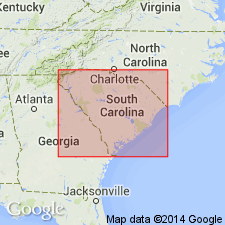
- Usage in publication:
-
- Perkins Bluff Member
- Modifications:
-
- Named
- Dominant lithology:
-
- Sand
- AAPG geologic province:
-
- Atlantic Coast basin
Summary:
The Perkins Bluff Member is here named the upper member of the Rhems Formation of the Black Mingo Group in the Coastal Plain of SC. The here revised Black Mingo Group includes all the strata from the base of the Paleocene to the top of the Ypresian Stage of the Eocene and is divided into the Danian Rhems Formation, the Thanetian Williamsburg Formation, and unnamed Ypresian strata. [In the Clubhouse Crossroads corehole No. 1, Gohn and others (1978) assigned the entire Paleocene section to the Black Mingo Formation, and Gohn and others (1983) named the Ypresian section the Fishburne Formation.] The Perkins Bluff Member consists of imbricated, pelecypod rich, partly silicified, argillaceous sand which forms a prominent ridge that extends along the Black River and overhangs the Browns Ferry Member of the Rhems, which it overlies with sharp erosional contact. Unconformably underlies the Lower Bridge Member of the Williamsburg Formation. Thickness at type section is 10 ft. Age is Paleocene (late Danian, middle Midwayan).
Source: GNU records (USGS DDS-6; Reston GNULEX).
For more information, please contact Nancy Stamm, Geologic Names Committee Secretary.
Asterisk (*) indicates published by U.S. Geological Survey authors.
"No current usage" (†) implies that a name has been abandoned or has fallen into disuse. Former usage and, if known, replacement name given in parentheses ( ).
Slash (/) indicates name conflicts with nomenclatural guidelines (CSN, 1933; ACSN, 1961, 1970; NACSN, 1983, 2005, 2021). May be explained within brackets ([ ]).

